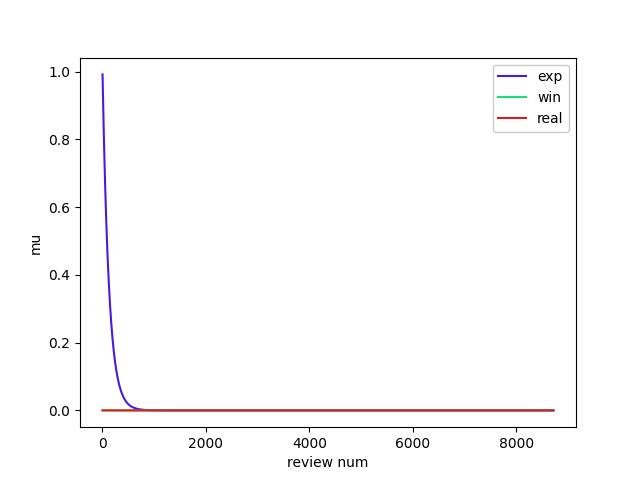graphid.core.refresh module¶
- class graphid.core.refresh.RefreshCriteria(window=20, patience=72, thresh=0.1, method='binomial')[source]¶
Bases:
objectDetermine when to re-query for candidate edges.
Models an upper bound on the probability that any of the next patience reviews will be label-changing (meaningful). Once this probability is below a threshold the criterion triggers. The model is either binomial or poisson. They both work about the same. The binomial is a slightly better model.
Does this by maintaining an estimate of the probability any particular review will be label-chaging using an exponentially weighted moving average. This is the rate parameter / individual event probability.
- pred_num_positives(n_remain_edges)[source]¶
Uses poisson process to estimate remaining positive reviews.
Multipling mu * n_remain_edges gives a probabilistic upper bound on the number of errors remaning. This only provides a real estimate if reviewing in a random order
Example
>>> # ENABLE_DOCTEST >>> from graphid.core.refresh import * # NOQA >>> from graphid import demo >>> infr = demo.demodata_infr(num_pccs=50, size=4, size_std=2) >>> edges = list(infr.ranker.predict_candidate_edges(infr.aids, K=100)) >>> #edges = util.shuffle(sorted(edges), rng=321) >>> scores = np.array(infr.verifier.predict_edges(edges)) >>> sortx = scores.argsort()[::-1] >>> edges = list(ub.take(edges, sortx)) >>> scores = scores[sortx] >>> ys = infr.match_state_df(edges)[POSTV].values >>> y_remainsum = ys[::-1].cumsum()[::-1] >>> refresh = RefreshCriteria(window=250) >>> n_pred_list = [] >>> n_real_list = [] >>> xdata = [] >>> for count, (edge, y) in enumerate(zip(edges, ys)): >>> refresh.add(y, user_id='user:oracle') >>> n_remain_edges = len(edges) - count >>> n_pred = refresh.pred_num_positives(n_remain_edges) >>> n_real = y_remainsum[count] >>> if count == 2000: >>> break >>> n_real_list.append(n_real) >>> n_pred_list.append(n_pred) >>> xdata.append(count + 1) >>> # xdoctest: +REQUIRES(--show) >>> import plottool_ibeis as pt >>> pt.qtensure() >>> n_pred_list = n_pred_list[10:] >>> n_real_list = n_real_list[10:] >>> xdata = xdata[10:] >>> pt.multi_plot(xdata, [n_pred_list, n_real_list], marker='', >>> label_list=['pred', 'real'], xlabel='review num', >>> ylabel='pred remaining merges') >>> stop_point = xdata[np.where(y_remainsum[10:] == 0)[0][0]] >>> pt.gca().plot([stop_point, stop_point], [0, int(max(n_pred_list))], 'g-')
- ave(method='exp')[source]¶
>>> from graphid import demo >>> infr = demo.demodata_infr(num_pccs=40, size=4, size_std=2, ignore_pair=True) >>> edges = list(infr.ranker.predict_candidate_edges(infr.aids, K=100)) >>> scores = np.array(infr.verifier.predict_edges(edges)) >>> #sortx = util.shuffle(np.arange(len(edges)), rng=321) >>> sortx = scores.argsort()[::-1] >>> edges = list(ub.take(edges, sortx)) >>> scores = scores[sortx] >>> ys = infr.match_state_df(edges)[POSTV].values >>> y_remainsum = ys[::-1].cumsum()[::-1] >>> refresh = RefreshCriteria(window=250) >>> ma1 = [] >>> ma2 = [] >>> reals = [] >>> xdata = [] >>> for count, (edge, y) in enumerate(zip(edges, ys)): >>> refresh.add(y, user_id='user:oracle') >>> ma1.append(refresh._ewma) >>> ma2.append(refresh.pos_frac) >>> n_real = y_remainsum[count] / (len(edges) - count) >>> reals.append(n_real) >>> xdata.append(count + 1) >>> # xdoctest: +REQUIRES(--show) >>> from graphid import util >>> util.qtensure() >>> util.multi_plot(xdata, [ma1, ma2, reals], marker='', >>> label_list=['exp', 'win', 'real'], xlabel='review num', >>> ylabel='mu')

- property pos_frac¶
- graphid.core.refresh.demo_refresh()[source]¶
CommandLine
python -m graphid.core.refresh demo_refresh \ --num_pccs=40 --size=2 --show
Example
>>> # ENABLE_DOCTEST >>> from graphid.core.refresh import * # NOQA >>> demo_refresh() >>> util.show_if_requested()
- graphid.core.refresh._dev_iters_until_threshold()[source]¶
INTERACTIVE DEVELOPMENT FUNCTION
How many iterations of ewma until you hit the poisson / biniomal threshold
This establishes a principled way to choose the threshold for the refresh criterion in my thesis. There are paramters — moving parts — that we need to work with: a the patience, s the span, and mu our ewma.
s is a span paramter indicating how far we look back.
mu is the average number of label-changing reviews in roughly the last s manual decisions.
These numbers are used to estimate the probability that any of the next a manual decisions will be label-chanigng. When that probability falls below a threshold we terminate. The goal is to choose a, s, and the threshold t, such that the probability will fall below the threshold after a maximum of a consecutive non-label-chaning reviews. IE we want to tie the patience paramter (how far we look ahead) to how far we actually are willing to go.